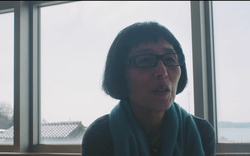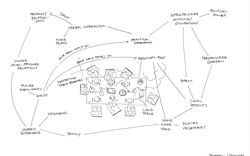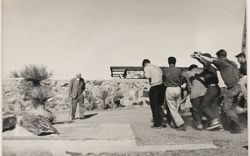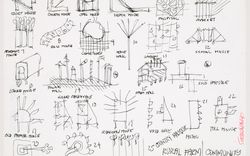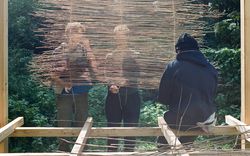The Posturban Phenomenon
An essay by Kayoko Ota
More months than not, Toyo Ito makes the six-hour trip from Tokyo to Omishima, an island in the west of Japan. To get there he takes a bullet train, a long-distance bus, and then a car. Upon his arrival, Ito meets with local authorities, project collaborators, and community stakeholders. Surprisingly enough, he doesn’t have any commissions on this island, rather, his work there is entirely on the grass-roots level, contributing his architectural expertise to improve existing communal facilities or create new ones, or mobilizing projects that are not immediately architectural in an effort to help mitigate the effects of the island’s thinning population. It is unusual for an architect to be committed to a place without clients, let alone in the countryside. Like most architects of his generation, Ito long considered the city the only place to work and construct a discourse. He did not think of anywhere else.
Today, however, more and more architects in Japan are looking beyond the city. Elsewhere in the Japanese archipelago, Kazuyo Sejima commutes to the tiny island of Inujima to carry out a long-term, participatory planning process focused on the landscape. In Momonoura, a fishing village in northern Japan that was affected by the 2011 earthquake and tsunami, Momoyo Kaijima and Yoshiharu Tsukamoto of Atelier Bow-Wow are coordinating rehabilitation efforts with the local community and a private fund for social recovery. In the town of Umaki, Toshikatsu Ienari of dot architects has helped reactivate a public space for residents and visitors alike, by devising a compound of wooden structures housing an open kitchen, local radio station, infirmary, goat hut, garden, and photo archive. Hajime Ishikawa, an unorthodox landscape architect and theorist, frequents a farming village on the island of Shikoku to learn from the creative skills of the old farmers who live there.
All of these islands and villages are, to different degrees, suffering from declining industrial activity and accelerated depopulation.1 Local governments are facing their limits. Poverty is severe. Even as the market economy progressively dominates the entire country, it seems to pass over these remote places located far from the big cities. In the past, an internationally recognized architect might have been invited to design an iconic building in islands and villages such as these. But now their visits to these same communities may indicate something new. In place of the conventional system of commissioning, a new kind of exchange is emerging between architects and their counterparts—local stakeholders, rather than clients. The architects seem extremely dedicated to this new relationship, fostered autonomously out of a desperate situation—not enough working population or any kind of income. What is this new form of exchange? What do architects offer to the countryside, and what do they gain from it?
-
Jinko gensho chizu [Depopulation map], The Nikkei, published online on 24 September 2014, https://www.nikkei.com/edit/interactive/population2014/map.html#!/z=6/. The data used for the mapping is based on research by the Japan Policy Council, the National Institute of Population and Social Security Research, and the Ministry of Internal Affairs and Communications, Japan. ↩
Twenty years ago, Cities on the Move, the landmark exhibition curated by Hou Hanru and Hans Ulrich Obrist, presented surprising forms of urbanity unfolding at an accelerated pace in Asian cities. Back then, we—the generations of architects including Ito, Sejima, and Atelier Bow-Wow—had a genuine curiosity for the metropolis as an infinitely mutating entity. Among the wonders of cities like Tokyo, Hong Kong, or Shanghai was their hyper-density. This excited us, and inspired our imagination. The thought that these cities would enter a phase of post-growth, bringing with it a decline in fertility and an increase in longevity, did not cross our minds.
Two major paradigm shifts have since occurred in Japan. The first is the shrinking and aging of the population—in the countryside, but also in big cities, to which Tokyo is no exception. The demographic decline is occurring at such a pace and scale that it feels as if the whole country has suddenly slipped into a new era, leaving it standing on an uncertain foundation. According to statistics released by the Tokyo Metropolitan Government, by 2035 one out of four people in Tokyo will be sixty-five or older, and nearly thirty percent of this elderly population will be living alone. The thinning of population is already contributing to vacant areas and abandoned houses in the capital, exacerbating the social and economic conditions of its neighbourhoods.
Yet even with the new social challenges facing Tokyo and other large cities in Japan, architects there are still not taking part in shaping the urban environment. A major factor behind this is the second paradigm shift: the monopolization of the planning and design of urban developments by major corporate design firms and the design arms of general contractors, developers, and housing companies. In addition to these more traditional players, companies in the technology, marketing, advertising, and security sectors, as well as think tanks, are entering the market. Urban planning today is carried out according to an increasingly corporate logic driven by the market economy, and underpinned by increasingly non-architectural thinking.
This phenomenon leaves less and less room for Japanese architects with individual calibre (and international recognition) to take part in the evolution of the city. Instead, they typically work on single- or multi-family dwellings, commercial complexes, or, in good years, competitions for public buildings. Renovations of existing structures have become especially common among young architects since the 2011 Tohoku earthquake and tsunami.
Of course, these two paradigm shifts are not exclusive to Japan. Shrinking cities and declining birthrates have been a concern in the industrialized countries of the West for a few decades. But it is also becoming an imminent condition for rapidly urbanizing countries such as China. The impact of neoliberal capitalism on urban governance and physical restructuring is another critical issue for those specializing in urban and architectural planning, regardless of where they are. In central Tokyo, for instance, the local and national governments have commissioned major urban developers to come up with master plans for redeveloping several districts (such as Shibuya and Shinjuku) since 2002. These schemes involve large amounts of space designated for public use, which allows developers to inflate building volumes thanks to deregulation. As a result, citizens earn more common space for consumption. The urban fabric becomes ever bigger and taller, despite a shrinking and hyper-aging population. The city, as the old premise and as planning context, is itself transforming.
Meanwhile, the processes of thinning and aging continue outside of Tokyo and other big cities. And a reaction to this is already occurring. Alarmed by the increasing seriousness of the problem in the countryside, a variety of initiatives for local regeneration have started to emerge. In some remote islands and mountain villages, a reversal of this trend has already been observed as a result.1 The number of emigrants and returnees to the countryside is increasing, too. A change in people’s values is perhaps a key factor in this phenomenon. The generations born after the beginning of the economic downturn in the 1990s no longer see the value of concentrating everything in Tokyo. People are no longer obsessed with the city, or with owning things.
Another factor to note is the permeability of the consumer market in Japan, which quickly responds to new or rare products. Agriculture, forestry, fishery, textile industry, handcraft manufacturing—these dying industries in the countryside are occasionally reinvented successfully by entrepreneurs, often by using advanced technology. Tourism, too, can be a magic bullet, even on small islands such as Inujima.
-
Ko Fujiyama, “Saishin no zenkoku-teki na jinko-dotai to denen-kaiki no kanosei” [The recent demographic movement across Japan and the prospect of moving to country life], report published 26 September 2017, http://www.mlit.go.jp/common/001203325.pdf. ↩
It is in this context that architects are traveling to islands and villages: they offer conditions not found in the cities where they are based. That’s a “gain” for architects, to answer my earlier question about the exchange between architects and their counterparts. One hypothesis for why it is that once the population of an area has thinned to a certain extent, a space is created for unconventional measures and experimentation, beyond the administrative frameworks and capitalist logics of urban centers. Architects who arrive in these places may, within this different context, attempt what had previously been limited or denied in the city and extend their repertoire of practice—if not in the form of traditional building design, then perhaps through architectural thinking or expanded research.
In the new relationships emerging in these islands and villages, architects have managed to realize a testing ground where they can insulate themselves from the systematic penetration of modernization and attempt to forge a new engagement with society—an act that is also one of professional survival in the face of capitalist urbanization. Atelier Bow-Wow, Sejima, Ito, and Ienari are all reclaiming a process of understanding society through elaborate research, defining needs with residents, and envisioning the various forms that a solution could take—all of which should take place prior to a design commission and which may not necessarily result in architecture. This process, which may be taken for granted when designing a house, is dispensed with once the market economy or the administration system is involved.
What is potentially significant is that this reclaimed conception process allows a new kind of planning or design procedure to take shape, one in which the ability of ‘participants’ to think architecturally is heightened. Both Atelier Bow-Wow and Sejima have the task of reactivating a village or an island in a highly flexible manner while being well integrated with residents. Within a loosely defined framework, Sejima is allowed to slowly but deliberately improvise ideas, think of how to put them into practice with the participation of local residents, visitors, artists, and students, and supervise the execution in a long term. The participants are encouraged to “learn by doing” in programs prescribed by Sejima. This process of “learning by doing” can stimulate the influx of people as well as the local economy.
In the case of Momonoura, where Kaijima of Atelier Bow-Wow is taking part in steering the long-term recovery plan, an alternative school was founded not only to train fishermen but experiment with a mutual exchange of skills—anyone can come here to teach his or her skills outside of the academic system. The open education program aims to foster future residents and entrepreneurs who could bolster the village’s recovery. This whole scenario is informed by the insights acquired throughout two decades of research and observations by the architects, from Made in Tokyo (Kajima Institute Publishing, 1996) to Behaviorology (Rizzoli, 2010). In a way, the Momonoura project is a touchstone of their work as close observers of the contemporary city and the behaviors of people who live in it.
The new kind of planning or designing that I describe here could be rephrased as a mutual and productive exchange between ‘the architect’ who mobilizes his or her architectural thinking, on the one hand, and the ‘residents et al.’ who can inform or enrich the architect’s thinking and eventually learn to think architecturally, on the other. In the same way that the concept of design thinking has changed the general notion of design, a wider dissemination of architectural thinking may broaden what participatory planning and designing can achieve. Perhaps an architect who succeeds in opening a new front in this relationship could be an “alternative to the individual genius or star” that, in Ito’s view, architecture desperately needs today.
“But all this is possible because the territory is so small,” Sejima reminds us. Writing about contemporary cities, Rem Koolhaas declares that “beyond a certain scale, architecture acquires the properties of Bigness.” Didn’t Sejima and the other architects arrive at smallness after struggling with all the complexities and opaqueness of Bigness? Have these Japanese architects detected the “properties of smallness” in islands and villages?
The experiments have just begun. Ideally, they should bring forth results that can be applied to the city in whatever possible form it might take. What Sejima said was encouraging: “Through this project [on Inujima], I came to think that maybe it’s possible to make changes to our urban environment in the way we want. I used to think this wasn’t possible. But now I feel an unexpectedly amusing place or time could emerge even in central Tokyo after the experience in Inujima.” One possibility could be claiming a small enclave in a city, where an experiment based on the achievement on the island could be implemented.
The result of the architects’ experiments may not manifest in the form of a style. But in the long run, the experience in the islands and villages may well cause a fundamental shift in architectural values and alter the architects’ practice altogether. The islands and villages are—potentially—a frontline of architectural reinvention today.
Kayoko Ota is curator of CCA c/o Tokyo, the second in a series of temporary initiatives that are locally anchored in different cities worldwide. This essay accompanies Islands and Villages, a documentary series we commissioned on the posturban phenomenon in rural Japan.

